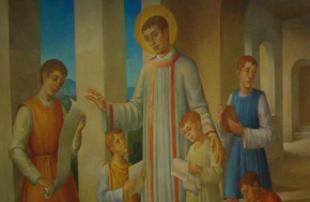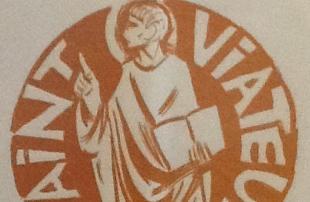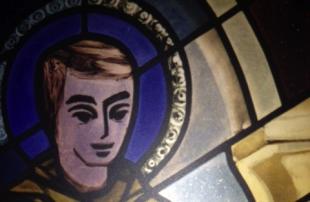Patron



SAINT VIATOR
BIOGRAPHICAL SKETCH
Viator, patron and model of the Viatorians
Even though it is generally assumed that Saint Viator was a young man when he participated in the events that have entered into history, this sketch assumes nothing about his age, since we do not know even the approximate date of his birth. He may have been a young man when he left Lyon for the deserts of Scete, but it is probable that he was an adult of uncertain age.
As first glance it may appear that almost nothing is known about Saint Viator. Yet, on reflection, it is remarkable that after almost 1600 years we know so much about a man whose life was unexceptional in all but holiness. This brief sketch illuminates only the traces that the man left in history. Meditation and reflection on fidelity, service, sacrifice and prayer, as these are required for living to the full the life of a disciple of Christ, whether in the fourth century or in the twentieth, will flesh out this meager portrait, and help us to envision and appreciate the value of his life.
Saint Viator was a lector of the Church of Lyon, and a disciple and companion of Bishop Just. He lived in the latter part of the fourth century, and died around the year 390.
What little is known of St. Viator is inextricably bound up with the life of his bishop who was born in Vivarais and became a deacon of the Church of Vienne. Sometime after 343, St.Just was chosen to succeed Bishop Verissimus, as bishop of Lyon. A contemporary biographer describes him as being a meek and merciful man. Two letters addressed to him by St. Ambrose suggest that he was also a man respected for his learning. In 374, Bishop Just assisted at regional Council at Valence. In 382, he attended the Council of Aquileia, as one of the two representatives of the Bishops of Gaul.
Shortly after returning from the Council of Aquileia, Bishop Just confided to Viator his intention to abandon the See of Lyon in order to take up the ascetical life a monk in the desert of Scete in Egypt. This decision seems to have been motivated by a number of factors: his character, that of a mild studious and contemplative man; his age, for he had been a bishop many years and it seems he was already in his sixties; and by a sad event which had occurred in Lyon a short time before.
A mad man had raced through the market place of the city, slashing wildly with a sword, and wounding and killing many citizens. He then dashed to the Cathedral and claimed the right of sanctuary. A mob gathered to storm the church, at that time located on the side of the present church of St. Nizier. Bishop Just intervened. He halted the mob, but under pressure of their violence he agreed to hand the man over to the magistrates for a fair trial. No sooner had this been done, than the mob seized the man from the magistrate’s guard, and killed him on the spot. The bishop came to believe that his failure to adequately protect the murderer had soiled him with the poor man’s blood, and therefore, he was unworthy to continue to lead the Christian community in celebrating the paschal mysteries, and that, in fact, his failure required him to devote the remainder of his life to doing penance.
Viator follows his bishop in the desert
It would seem that before the year 381 was out, Bishop Just secretly left Lyons for Marseilles, where he would take ship to Alexandria in Egypt. Viator, knowing his intentions, decided to follow his bishop and master. He caught up with the bishop at Marseilles, and together they boarded ship for Egypt.
Once in Egypt, they joined the community of monks in the desert of Scete, about 40 or 50 miles south of Alexandria, beyond the mountains of Nitria, in the Libyan Desert. At that time the leader or abbot of this community was St. Macarius of Egypt (or the Elder) († 390), a disciple of one of the founders of monasticism in Egypt, St. Anthony († 356). Macarius had a reputation for great holiness and a fierce asceticism. Most of the monks lived in cells, either dug in the ground or built of stones, and each out of sight of others. They came together only on Saturdays to celebrate the liturgy. They supported themselves by manual labor, and ate only the poorest of foods. Fasting, prayer, silence, and the keeping of night vigils, characterized their lives.
It would seem that Bishop Just and his lector, Viator, did not reveal their identities to the community they had joined in Egypt. Yet, by chance, several years after their arrival, a pilgrim from Lyon recognized them, and urged them to return with him. They refused. Apparently, on his return to Lyons, the pilgrim informed the Church there, for shortly afterwards, a priest of Lyons, Antiochus, who later was to become the bishop of Lyons, was sent to persuade the two men to return and take up their lives again in Lyon. His efforts failed.
Tradition has it that Bishop Just died soon after the visit of Antiochus, probably around the year 390, and that Viator died shortly thereafter. The cause of these deaths is unknown. Perhaps, in the case of Bishop Just, it was simply old age. Viator’s death so soon after that of his bishop and friend suggests that weakened by grief and the rigors of life in the desert, he could become a victim of disease, which periodically reached epidemic proportions in monastic communities. Such an epidemic practically wiped out the monastic community of Pachomius in 349 in the Thebaid.
When news of these deaths reached Lyon, arrangements were made to bring the bodies of these two saintly men back to Lyons. At the time, the monastic life was venerated as a form of martyrdom, and the earthly remains of holy monks were honored as much of those of martyrs.
The bodies of Just and Viator were returned to Lyon sometime before the end of the century, probably 399. A well-founded tradition reports that the bodies of the two saints arrived in the city on August 4. They were placed in the Cathedral or possibly the new church of St. Stephen, until a final place could be prepared in the Church of Maccabees, just outside the city walls. On Sept. 2, the relics were solemnly transferred to the Church of the Maccabees, to which title, the name of St. Just would soon be added.
Worship to St. Just and St. Viator
The cult of St. Just, and that of his lector, Viator, soon overshadowed that of his famous predecessors, St. Pothinius, founding bishop of the Church of Lyon, and martyr; and St. Irenaeus, the second bishop of Lyons, a doctor of the Church, and also a martyr. By the fifth century, there were four feast days celebrating the lives of these two men: August 4 marked by the arrival of the relics in Lyon; Sept. 2 was the celebration of the transfer of the relics to the Church of the Maccabees; Oct. 14 marked the departure of the two saints for Egypt; and Oct. 21 was a particular feast of St. Viator. Several martyrologies mention a fifth feast, probably in December, to commemorate the death of St. Just.
On Aug. 29, 1287, William of Valence, Archbishop of Vienne, at the request of the bishop-elect of Lyons and the chapter of the Church of the Maccabees and St. Just, authorized and presided over an official verification of the relics in the crypt of the Church of the Maccabees and St. Just. The Archbishop had delegated eight theologians, four Dominicans and four Franciscans, to verify the relics. The body of St. Just and that of St. Viator were found in the same tomb. The tomb also contained documents attesting to the life and holiness of St. Viator. Unfortunately, these were lost later. On Sept. 2, 1287, the relics of each saint were placed in separate richly ornamented chests and buried in the new crypt.
In September 1562, the Calvinists attacked the city of Lyon. They destroyed the Church of St. Just, but some of the relics of St. Just and St. Viator were transferred to a new Church of St. Just, hastily constructed just inside the city walls in 1564. In the years that followed, this church was enlarged and remodeled several times. In 1793 during the French Revolution the Church of St. Just was again desecrated, but once again the relics were saved; this time by the sacristan.
J. Linnan, c.s.v.



